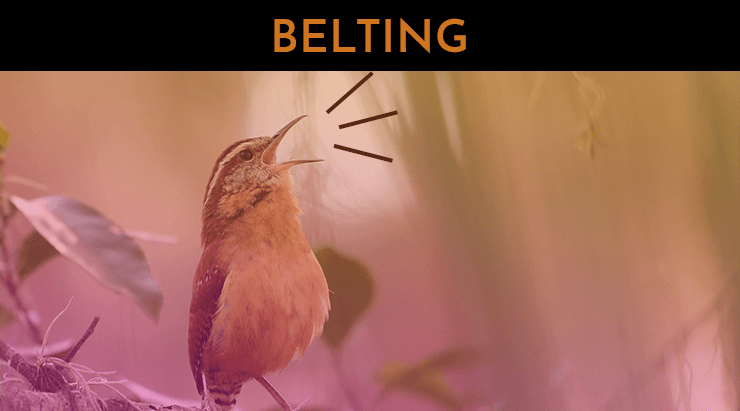Belting
August 4, 2019By Nellie Vinograd

Belting. Without being able to define it, you can probably think of many examples of this term, which is just extending or stretching the chest voice to a point where it creates a powerful and bright sound, usually on a higher pitch. Another way to view it is singing in your head-voice but with the support and strength of your chest voice. It’s not screaming, it’s not a harsh, guttural growl and on the other end, it’s not just a loud high-note. Sometimes the term is used colloquially to refer to singing in a powerful way, but belting is a specific sound and skill. Belting requires support, control, focus, energy, and practice – but we’ll get to that.
It can be helpful to find some belting role models to better understand (and mimic) the sound you’re looking for. Belting is a technique found in various genres, like pop, gospel, R&B, and musical theater. Research great belters like Whitney Houston, Christina Aguilera, Sutton Foster, Aretha Franklin and Idina Menzel and you’ll realize that they all have their own distinct style. On a side note, you’ll realize that belting is not appropriate for every song and genre – its intensity may not fit the gentle tone of folk music, for example.
It’s important to know what moment you’re going to use your belting voice for. The technique should be used sparingly for emotional emphasis. If a singer is belting their way through an entire musical, it’s not as impactful when their character releases a final belted phrase at the climax of the story. Not to mention, that singer will probably be ready to pass out by curtain call. Belting should be reserved both because it is taxing on the voice and because it is a powerful, emotional tool.
 Check out an entire tutorial on healthy Belting here.
Check out an entire tutorial on healthy Belting here.
Belting requires a lot of practice. This is not a trick you’re going to pick up on your first try, but rather an intensive, long-term skill that even experienced singers can struggle with. This is not to say don’t bother, but be prepared to put in extended effort if you want to see results. Confidence is essential. If you back away from the sound you’re creating or get intimidated by the intensity of your singing, you’ll lose your stamina. Stay focused and be content with not creating the prettiest sound right away. Getting started, you might feel whiny or nasally as you find your placement. Focus first on getting the energy and support for your sound, and the pitch and tone can be cleaned up later. Find a comfortable, private location to practice in if you’re feeling self-conscious.
Before delving into technique, it’s important to note that with belting, it’s really more of an art than an exact science, so feel encouraged to personalize your technique and find the visualization that best allows you to relax into the sound. These instructions are meant to be a starting place, not the final say on the matter.
Now let’s get to the nitty gritty. Belting is all about strong, reinforced vibrations. That means you are going to have to provide your voice with a lot of physical support. Before you start singing, establish a grounded, proper posture: standing up tall, feet firmly planted, shoulders down and back, arms at your sides, neck straight. Good posture will ensure you’re not cutting off your breath and that you are giving your voice as much support as possible. You won’t actually be releasing as much breath during a belt as you’d think (in general, high notes release less air than low notes), but maintaining breath control will be essential. After fiddling with your posture, do some deep breathing exercises to make sure your lungs and diaphragm are engaged and ready to support your sound.
Because belting can be so strenuous, specialized warm-ups are key. If you’re a soprano, engaging your chest voice might feel like a new sensation, so spend a few warm-ups in a low, chest-voice range. Certain vocalizations like the “Nyah” sound or nasally “Ay” and “Eh” sounds can also help you utilize your chest voice and get your jaw used to creating space for that ringing tone. Another warm-up technique is starting with your talking voice, repeating a word like “Hey!” and easing into sing-speaking, or speaking on a pitch. Exercises that utilize a glottal stop can be helpful, as well.
Finally, when you start to sing with your full voice, you want the sound to be focused, almost pin-pointed, towards your hard palate, as that’s where we create that bright, energized and powerful vibration that defines the belt. Imagine as you sing that you’re pulling the sound from your chest and pushing it towards your cheeks and nose in a singular, circular motion. Another way to think about placement is as if you’re biting into the sound with your top row of teeth. At the same time, though, you want to create plenty of space for the sound to “bounce” and resonate, so be sure to keep the bottom part of your jaw and your tongue lowered. Seems tricky, right? Eventually you’ll be able to push aside all the technical notes and release your sound confidently and beautifully. But until then: practice, practice, practice!


